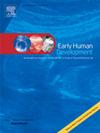孕妇同时使用多种神经精神药物与新生儿戒断综合征的关系
IF 2
3区 医学
Q2 OBSTETRICS & GYNECOLOGY
引用次数: 0
摘要
目的新生儿戒断综合征的特点是新生儿因分娩后停止经胎盘药物转移而出现戒断症状。本研究旨在检查戒断症状的危险因素,以阐明怀孕期间服用神经精神药物数量的影响。方法本研究是一项回顾性观察性研究,包括341名母亲在怀孕期间服用神经精神药物,包括抗精神病药、抗抑郁药、抗癫痫药和抗焦虑药/镇静剂所生的344名新生儿。使用Isobe评分评估戒断症状的存在,包括15种症状。进行多变量logistic回归分析以确定出现戒断症状的重要危险因素。结果178例(51.7%)新生儿出现戒断症状。接受≥3种神经精神药物治疗的母亲所生的新生儿出现戒断症状的频率高于接受1-2种神经精神药物治疗的母亲所生的新生儿(73.2% vs 45.0%; P < 0.001)。经多变量logistic回归分析,出现戒断症状与妊娠期间同时使用≥3种神经精神药物(校正优势比2.24,95%可信区间1.09 ~ 4.62,P = 0.029)和母体使用抗精神病药物(校正优势比1.77,95%可信区间1.06 ~ 2.94,P = 0.028)相关。结论孕期同时使用≥3种神经精神药物及母体使用抗精神病药物是发生戒断症状的重要危险因素。本文章由计算机程序翻译,如有差异,请以英文原文为准。
Association of neonatal withdrawal syndrome with concurrent use of multiple neuropsychiatric medications in pregnant women
Aim
Neonatal withdrawal syndrome is characterized by withdrawal symptoms in neonates because of the discontinuation of transplacental drug transfer after delivery. This study aimed to examine the risk factors for withdrawal symptoms to clarify the impact of the number of neuropsychiatric drugs administered during pregnancy.
Methods
This was a retrospective observational study including 344 neonates born to 341 mothers receiving neuropsychiatric drugs, including antipsychotics, antidepressants, antiepileptics, and anxiolytics/sedatives during pregnancy. The presence of withdrawal symptoms was assessed using the Isobe score, comprising 15 symptoms. Multivariable logistic regression analysis was performed to identify significant risk factors for the presence of withdrawal symptoms.
Results
Withdrawal symptoms developed in 178 (51.7 %) neonates. The frequency of neonates with withdrawal symptoms was higher in neonates born to mothers receiving ≥3 neuropsychiatric drugs compared to those born to mothers receiving 1–2 neuropsychiatric drugs (73.2 % vs. 45.0 %; P < 0.001). By multivariable logistic regression analysis, the presence of withdrawal symptoms was associated with the concurrent use of ≥3 neuropsychiatric drugs during pregnancy (adjusted odds ratio, 2.24; 95 % confidence interval, 1.09–4.62; P = 0.029) and the maternal use of antipsychotics (adjusted odds ratio, 1.77; 95 % confidence interval, 1.06–2.94; P = 0.028).
Conclusions
The concurrent use of ≥3 neuropsychiatric drugs during pregnancy and the maternal use of antipsychotics were significant risk factors for the presence of withdrawal symptoms.
求助全文
通过发布文献求助,成功后即可免费获取论文全文。
去求助
来源期刊

Early human development
医学-妇产科学
CiteScore
4.40
自引率
4.00%
发文量
100
审稿时长
46 days
期刊介绍:
Established as an authoritative, highly cited voice on early human development, Early Human Development provides a unique opportunity for researchers and clinicians to bridge the communication gap between disciplines. Creating a forum for the productive exchange of ideas concerning early human growth and development, the journal publishes original research and clinical papers with particular emphasis on the continuum between fetal life and the perinatal period; aspects of postnatal growth influenced by early events; and the safeguarding of the quality of human survival.
The first comprehensive and interdisciplinary journal in this area of growing importance, Early Human Development offers pertinent contributions to the following subject areas:
Fetology; perinatology; pediatrics; growth and development; obstetrics; reproduction and fertility; epidemiology; behavioural sciences; nutrition and metabolism; teratology; neurology; brain biology; developmental psychology and screening.
 求助内容:
求助内容: 应助结果提醒方式:
应助结果提醒方式:


